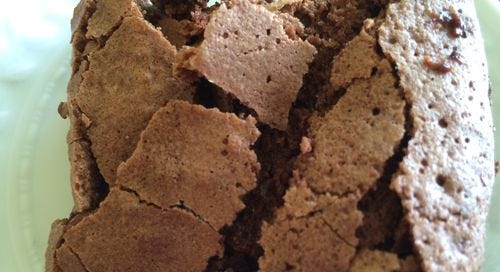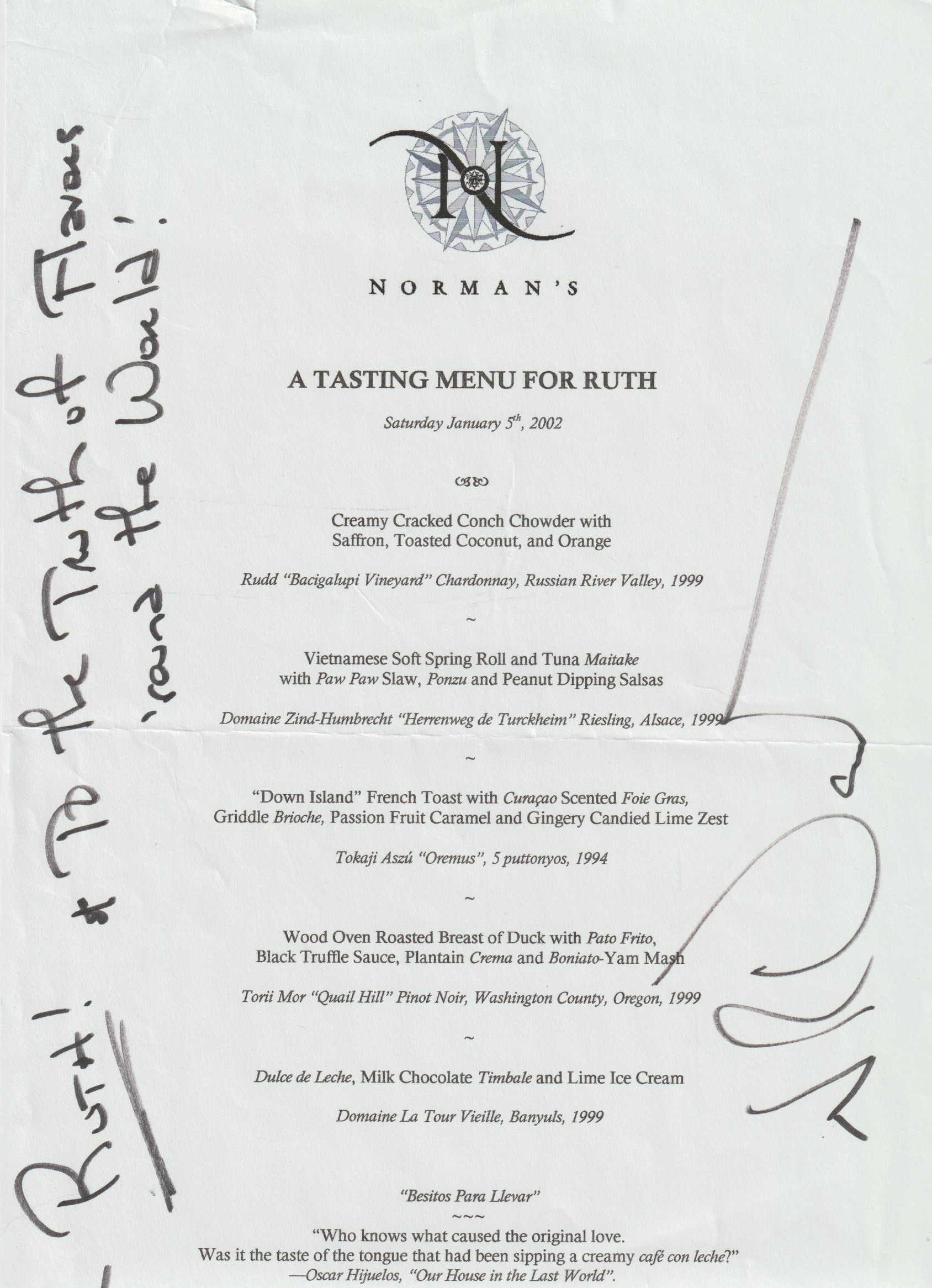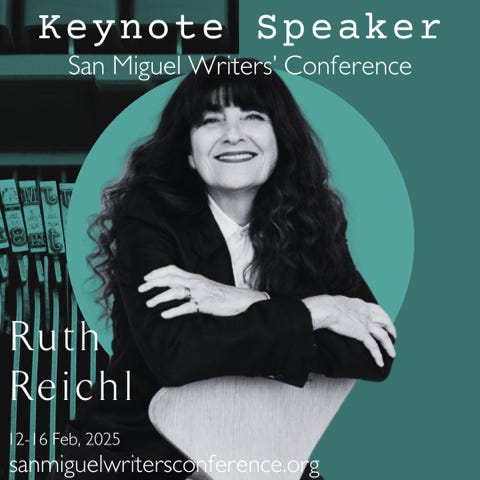Is Food Political?
Also, the very best brownies. New ways with old bread. A fantastic vintage menu. And a writer's retreat.
I ran this piece when La Briffe was brand new and had very few readers - so apologies to those who were with me then. But given the response to last week’s column- many people cancelled their subscriptions because it was “too political” - I feel compelled to run this again.
Whenever I want to illustrate that food is about much more than recipes and restaurant reviews I pull out a note that I’ve been carrying around — both in my head and literally — for the past thirty years. On March 14, 1991, an irate reader tore off the cover of the Food Section of the Los Angeles Times and scrawled a diatribe across it. She was enraged because we had featured articles about two superb cooks. One was Sri Lankan, the other was learning to cook from her Vietnamese mother-in-law; both featured recipes I’m proud to have published.
“What kind of mentality do the people you employ have!” she wrote. “Disgusting — and stupid — Oriental food during St. Patrick’s celebration which is an American tradition.”
And then, still irate, “I am not Irish, but everyone in the U.S.A. recognizes this day. That is if they are American. They prepare Irish food. Octopus soup has its place, but not on St. Patrick’s day.”
I wrote the reader back, saying that she was correct in saying that this is an American tradition; corned beef and cabbage are not actually eaten in Ireland on St. Patrick’s day. I added that since early Irish immigrants to America tended to live in the same neighborhoods as Jewish immigrants, they bought their brisket for corned beef from Kosher butchers so St. Patrick’s Day might be considered a Jewish tradition as well.
Not surprisingly, I did not hear back.
Thirty years have passed, and things have changed. But we are still trying to prove that we’re American by cooking the “right foods”, and we’re still arguing over what they are. The conversation has intensified in strange ways. In 1991 some people thought that you had to cook corned beef and cabbage on St. Patrick’s Day to prove your patriotism. Today some people wonder whether they have a right to these recipes if they are not of Irish extraction.
As new immigrants arrive on our shores, as they always have, the definition of American food continues to change. What is American? The question brings up very complicated issues. Not so long ago when White chefs cooked Mexican or Chinese food it was considered an homage; today it is sometimes considered theft. I expect our notions about this will evolve.
Consider, for instance, the recent elevation of an entirely new category of food: Chinese-American, Italian-American, Mexican-American, etc. Chefs are creating fancied-up or playful takes on orange chicken, spaghetti and meatballs and hard-shell tacos. Once considered bastardized versions of classic cuisines, they have now become both beloved and respectable. But who is actually entitled to those recipes? Must you be a third generation hyphenate-American before you can claim them as your own? Certainly the communities who bring their flavors and techniques to our country and our tables deserve credit; at what point do those ideas become so wide-spread that they move into the public domain?
I’ve had some uncomfortable brushes with these issues. In 2007 it occurred to me that while Gourmet had published many excellent articles on the food of Mexico, the magazine had never devoted much energy to the rest of Central and South America. We decided to produce an issue about what we today might call Latinx cooking. I’m proud of that issue; it featured moving pieces by Ana Menéndez, Junot Díaz and Rubén García, an interview with Maricel Presilla, and articles on the cooking of Mexico, Puerto Rico, El Salvador and the Dominican Republic. I naively did not think of this as a statement, and was stunned when our mail was filled with vitriol. Letter after letter howled, “Keep your politics out of my magazine.” On its face, there was hardly a “political” word in the magazine. But the readers sensed that its very existence was a political statement. And to a degree, they were right.
But I have always believed that food is political. And that when we ask, “What is American food?” we are not asking what’s for dinner. We’re asking who we are.
So yes, Mrs. Phillips. Octopus soup does have a place at the table. But today we’d probably also be asking about the provenance of the octopus. Who fished it? What were they paid? And should we even be eating these smart, graceful creatures in the first place?
When I consider that long-ago letter, it underscores, for me, that food —and all the issues surrounding it — contain the entire world.
Here’s one recipe that we can all agree is American. And as far as I’m concerned, this is the finest version of the beloved brownie.
Brownies are the ultimate cheap trick; it takes less than five minutes to throw the classic recipe together, they bake in a flash - and everybody loves them. As far as I’m concerned, there is no such thing as a bad brownie.
But having so few ingredients means that it's remarkably easy to improve the recipe. Replace ordinary ingredients with spectacular ones and you end up with something rich, dark and deep that lingers in your memory long after the last crumb is gone.
But it's not all about ingredients. When a recipe is this simple, technique can also change it enormously. In this version, I double the ingredients in the classic recipe and use a stand mixer to whip the eggs and sugar into a frenzy. The result is a taller, denser brownie with a deep fudge-like interior and a crackling meringue-like top that crunches when you take a bite. (Stir by hand, and you’ll end up with a denser, thinner brownie that some people prefer.)
However you choose to make it, this is a brownie that combines sweetness with the rich sophisticated complexity of chocolate - a little bite of childhood wrapped in a very grown-up package.
Memorable Brownies
2/3 cup (5 ounces) unsalted high-fat butter (like Plugra)
5 ounces unsweetened excellent chocolate (I used Dandelion Camino Verde from Ecuador)
2 cups sugar
2 teaspoons vanilla extract
4 organic eggs
1/2 teaspoon salt
1 cup all-purpose white flour, sifted
To prepare the pan, butter a 9X9 square pan and line the bottom with parchment paper. Butter the bottom again and lightly dust the pan with chocolate or cocoa powder.
Preheat the oven to 400 degrees.
Melt the chocolate and the butter over low heat, stirring constantly until the mixture is smooth and glossy. Stir in the vanilla.
Beat the eggs and salt in a stand mixer. Add the sugar and beat on high for about 10 minutes, until the mixture has turned quite white. Add the chocolate mixture to the eggs, beating on low until just mixed.
Gently stir in the flour until it just disappears.
Pour the batter into the prepared pan, place in the middle of the oven and immediately turn the temperature down to 350 degrees.
Bake for 40 minutes; the brownies will be quite fudgey and a toothpick should come out not quite clean. Cool on a rack.
Invert the pan, remove the parchment paper and invert again onto a cutting surface.
Speaking of economy…here’s another extremely useful recipe.
Ode to Stale Bread
Three different kinds of leftovers are crammed into my freezer: rinds of parmesan cheese, bones and shells from the animals we’ve eaten, and every spare crumb of bread. Just knowing it’s all there makes me feel safe: no matter what may come, we will not starve.
I wait until these dribs and drabs have become a crowd; then the cheese and bones become broth and the ancient bread is toasted into crumbs.
Home Made Breadcrumbs
Cut a good loaf of hard stale bread into cubes and grind it into crumbs in a blender.
Spread the crumbs onto a baking sheet and toast in a 350 degree oven for about 20 minutes until they are crisp and golden. Drizzle with olive oil (about a quarter cup for every 2 cups of crumbs), toss well with a fork to make sure that the oil is evenly distributed, season with salt and allow to cool completely before putting into containers.
These will keep in the freezer almost indefinitely. They keep their integrity in the freezer, which means that you can reach in, scoop out as many as you want without defrosting the entire lot. Give them a little buzz in the microwave for a few seconds before adding them to a dish, just to take the chill off.
My favorite way to use breadcrumbs is this easy dish.
Crumby Pasta
3 tablespoons olive oil, divided
1 small lemon
1 clove garlic
¾ cup bread crumbs
Pinch red pepper
Salt and fresh black pepper
1 small bunch of parsley, chopped
½ pound dried spaghetti
Grate the peel from the lemon. Squeeze the juice into a separate bowl. Mince the garlic.
Put a tablespoon of olive oil into a small frying pan, and when it is warm, add the lemon zest and garlic and stir for a minute or so until the fragrance is floating in the air. Now add the breadcrumbs and stir them in the warm pan. Add the red pepper, salt and a good amount of pepper, turn off the heat and set aside. When the crumbs are cool, add the chopped parsley.
Cook the spaghetti in a pot of well salted water until just al dente. Save a cup of the starchy water and drain pasta.
Put the pasta into a bowl. Add the remaining two tablespoons of olive oil, the lemon juice and a few tablespoons of pasta water and toss like mad until the pasta is gleaming. Add more of the pasta water as needed.
Now add the green, garlicky breadcrumbs and taste for seasoning. You may want to add more salt, pepper or lemon. Or, if you’re feeling profligate, some grated parmesan cheese. Then serve to two very lucky people.
Variation:
I almost always add anchovies to my pasta, but I’ve left them out because so many people dislike them. But if you love anchovies as much as I do, stir a few chopped anchovies into the oil with the garlic and lemon until they have completely disintegrated, and then toss in the bread crumbs. You will, of course, require less salt.
The late great Charlie Trotter called Norman Van Aken “the Walt Whitman of American cuisine.” It doesn’t get more American than that.
I love this menu: it’s an early nod to fusion cooking with global references to far-flung food. I remember the meal as being excitingly delicious.
I don’t tell you about every appearance I make, but here’s one that takes place next February that I’m really thrilled about. I’ve never been to the San Miguel de Allende Writer’s Conference, but everyone who’s attended raves about it. All the pertinent information is here.














I have always enjoyed your writing, from the days you were at the LA Times to your Gourmet days. I was in mourning with you at the demise of Gourmet magazine. In the past, for most of the population, it used to be ok to be liberal, conservative, Catholic, Presbyterian, agnostic, etc. etc. in this country. People acknowledged it and went on about their business. Now it seems more people take offense and go on the attack as though they are personally being offended by an opinion. Sadly, intolerance has taken over and right to freedom of speech has gone away. So, just to counteract the intolerance, I just became a paid member! Thank you Ruth! I welcome your opinions!
You are a gift. Period, full stop. xx